Victoria University Contract Law Assignment: Case Analysis and ACL
VerifiedAdded on 2020/04/07
|16
|2983
|50
Homework Assignment
AI Summary
This assignment analyzes a contract law case involving Mary and Lianne, focusing on the formation of a contract through offer and acceptance. The solution examines the initial advertisement as an invitation to treat, the exchange of emails constituting offers and counteroffers, and the application of the Electronic Transactions Act 1999. It assesses whether a valid contract was formed, considering the timing of acceptance and the validity of consideration. Furthermore, the assignment explores Lianne's rights under the Australian Consumer Law (ACL), specifically regarding misleading conduct and false representations by Mary. The analysis concludes that a contract was indeed formed and Lianne has rights under ACL. The second part of the assignment discusses the implications of business advertisements in contract law.
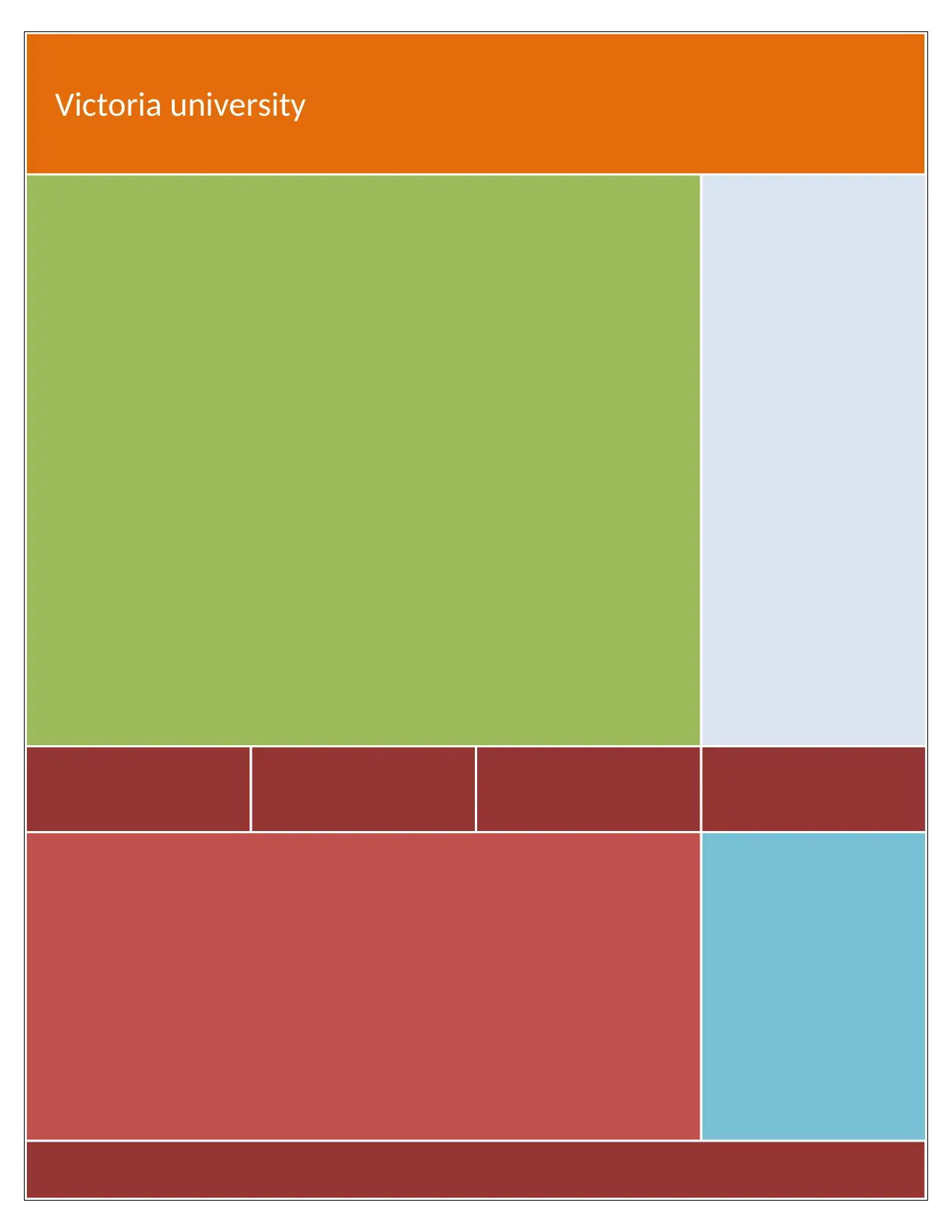
Victoria university
Paraphrase This Document
Need a fresh take? Get an instant paraphrase of this document with our AI Paraphraser
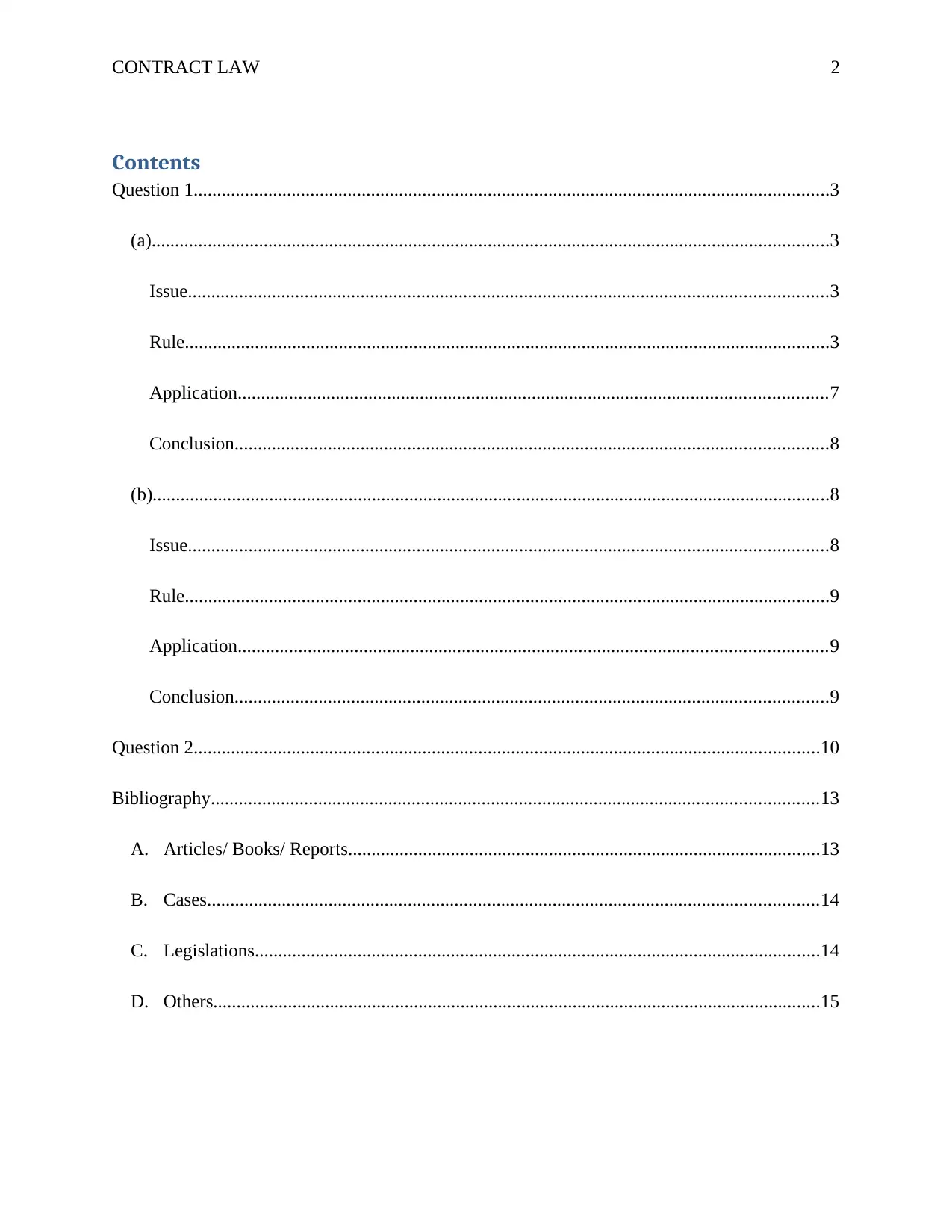
CONTRACT LAW 2
Contents
Question 1........................................................................................................................................3
(a).................................................................................................................................................3
Issue.........................................................................................................................................3
Rule..........................................................................................................................................3
Application..............................................................................................................................7
Conclusion...............................................................................................................................8
(b).................................................................................................................................................8
Issue.........................................................................................................................................8
Rule..........................................................................................................................................9
Application..............................................................................................................................9
Conclusion...............................................................................................................................9
Question 2......................................................................................................................................10
Bibliography..................................................................................................................................13
A. Articles/ Books/ Reports.....................................................................................................13
B. Cases...................................................................................................................................14
C. Legislations.........................................................................................................................14
D. Others..................................................................................................................................15
Contents
Question 1........................................................................................................................................3
(a).................................................................................................................................................3
Issue.........................................................................................................................................3
Rule..........................................................................................................................................3
Application..............................................................................................................................7
Conclusion...............................................................................................................................8
(b).................................................................................................................................................8
Issue.........................................................................................................................................8
Rule..........................................................................................................................................9
Application..............................................................................................................................9
Conclusion...............................................................................................................................9
Question 2......................................................................................................................................10
Bibliography..................................................................................................................................13
A. Articles/ Books/ Reports.....................................................................................................13
B. Cases...................................................................................................................................14
C. Legislations.........................................................................................................................14
D. Others..................................................................................................................................15
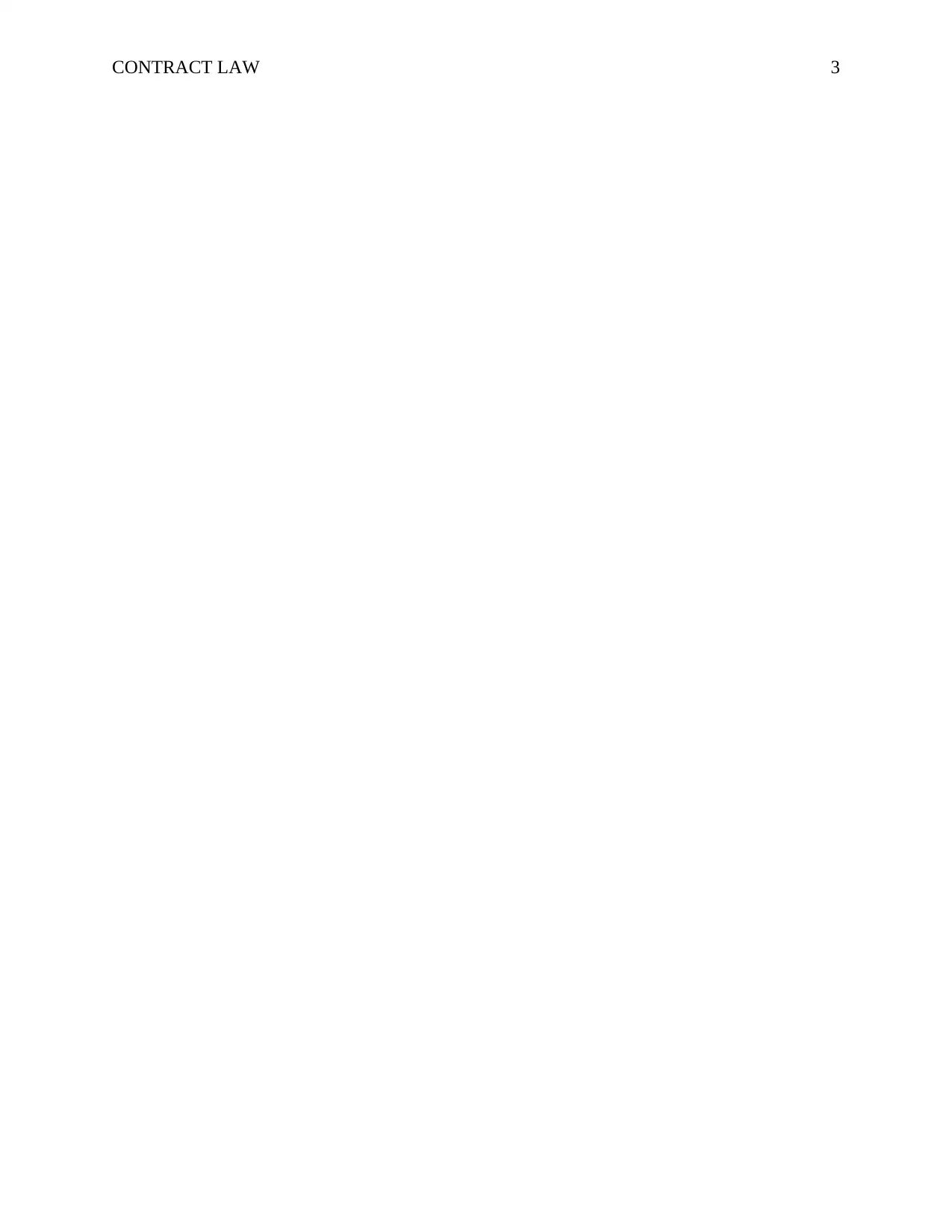
CONTRACT LAW 3
⊘ This is a preview!⊘
Do you want full access?
Subscribe today to unlock all pages.

Trusted by 1+ million students worldwide
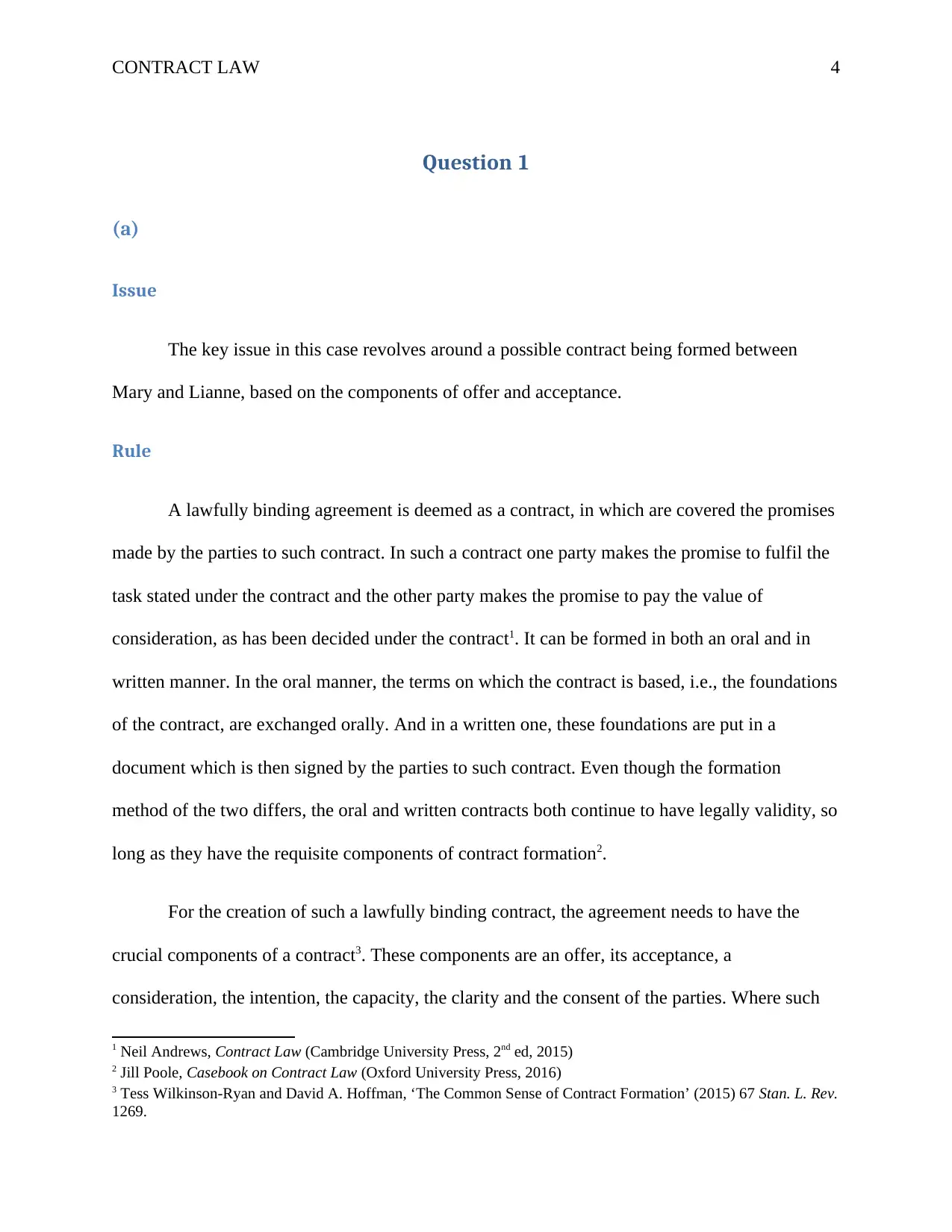
CONTRACT LAW 4
Question 1
(a)
Issue
The key issue in this case revolves around a possible contract being formed between
Mary and Lianne, based on the components of offer and acceptance.
Rule
A lawfully binding agreement is deemed as a contract, in which are covered the promises
made by the parties to such contract. In such a contract one party makes the promise to fulfil the
task stated under the contract and the other party makes the promise to pay the value of
consideration, as has been decided under the contract1. It can be formed in both an oral and in
written manner. In the oral manner, the terms on which the contract is based, i.e., the foundations
of the contract, are exchanged orally. And in a written one, these foundations are put in a
document which is then signed by the parties to such contract. Even though the formation
method of the two differs, the oral and written contracts both continue to have legally validity, so
long as they have the requisite components of contract formation2.
For the creation of such a lawfully binding contract, the agreement needs to have the
crucial components of a contract3. These components are an offer, its acceptance, a
consideration, the intention, the capacity, the clarity and the consent of the parties. Where such
1 Neil Andrews, Contract Law (Cambridge University Press, 2nd ed, 2015)
2 Jill Poole, Casebook on Contract Law (Oxford University Press, 2016)
3 Tess Wilkinson-Ryan and David A. Hoffman, ‘The Common Sense of Contract Formation’ (2015) 67 Stan. L. Rev.
1269.
Question 1
(a)
Issue
The key issue in this case revolves around a possible contract being formed between
Mary and Lianne, based on the components of offer and acceptance.
Rule
A lawfully binding agreement is deemed as a contract, in which are covered the promises
made by the parties to such contract. In such a contract one party makes the promise to fulfil the
task stated under the contract and the other party makes the promise to pay the value of
consideration, as has been decided under the contract1. It can be formed in both an oral and in
written manner. In the oral manner, the terms on which the contract is based, i.e., the foundations
of the contract, are exchanged orally. And in a written one, these foundations are put in a
document which is then signed by the parties to such contract. Even though the formation
method of the two differs, the oral and written contracts both continue to have legally validity, so
long as they have the requisite components of contract formation2.
For the creation of such a lawfully binding contract, the agreement needs to have the
crucial components of a contract3. These components are an offer, its acceptance, a
consideration, the intention, the capacity, the clarity and the consent of the parties. Where such
1 Neil Andrews, Contract Law (Cambridge University Press, 2nd ed, 2015)
2 Jill Poole, Casebook on Contract Law (Oxford University Press, 2016)
3 Tess Wilkinson-Ryan and David A. Hoffman, ‘The Common Sense of Contract Formation’ (2015) 67 Stan. L. Rev.
1269.
Paraphrase This Document
Need a fresh take? Get an instant paraphrase of this document with our AI Paraphraser
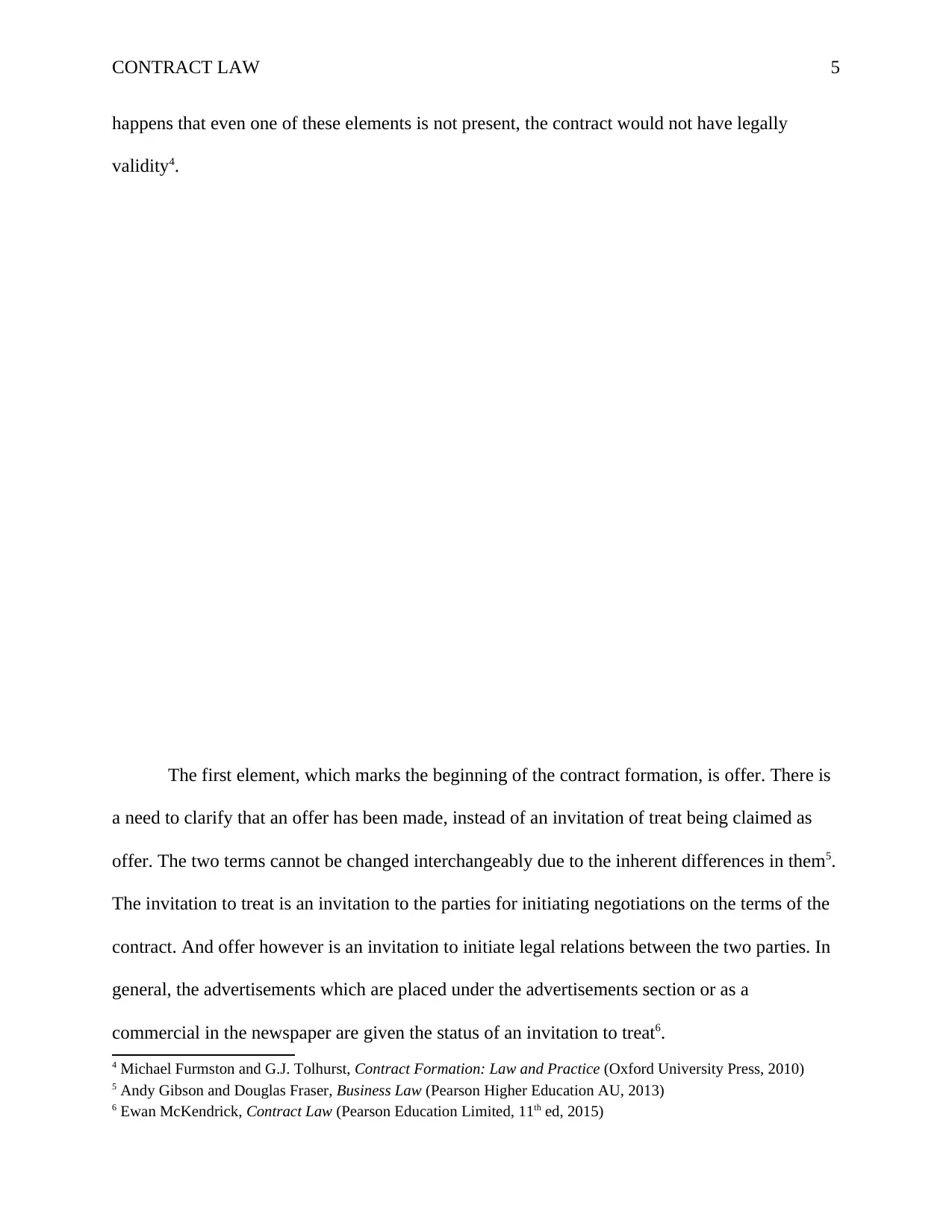
CONTRACT LAW 5
happens that even one of these elements is not present, the contract would not have legally
validity4.
The first element, which marks the beginning of the contract formation, is offer. There is
a need to clarify that an offer has been made, instead of an invitation of treat being claimed as
offer. The two terms cannot be changed interchangeably due to the inherent differences in them5.
The invitation to treat is an invitation to the parties for initiating negotiations on the terms of the
contract. And offer however is an invitation to initiate legal relations between the two parties. In
general, the advertisements which are placed under the advertisements section or as a
commercial in the newspaper are given the status of an invitation to treat6.
4 Michael Furmston and G.J. Tolhurst, Contract Formation: Law and Practice (Oxford University Press, 2010)
5 Andy Gibson and Douglas Fraser, Business Law (Pearson Higher Education AU, 2013)
6 Ewan McKendrick, Contract Law (Pearson Education Limited, 11th ed, 2015)
happens that even one of these elements is not present, the contract would not have legally
validity4.
The first element, which marks the beginning of the contract formation, is offer. There is
a need to clarify that an offer has been made, instead of an invitation of treat being claimed as
offer. The two terms cannot be changed interchangeably due to the inherent differences in them5.
The invitation to treat is an invitation to the parties for initiating negotiations on the terms of the
contract. And offer however is an invitation to initiate legal relations between the two parties. In
general, the advertisements which are placed under the advertisements section or as a
commercial in the newspaper are given the status of an invitation to treat6.
4 Michael Furmston and G.J. Tolhurst, Contract Formation: Law and Practice (Oxford University Press, 2010)
5 Andy Gibson and Douglas Fraser, Business Law (Pearson Higher Education AU, 2013)
6 Ewan McKendrick, Contract Law (Pearson Education Limited, 11th ed, 2015)
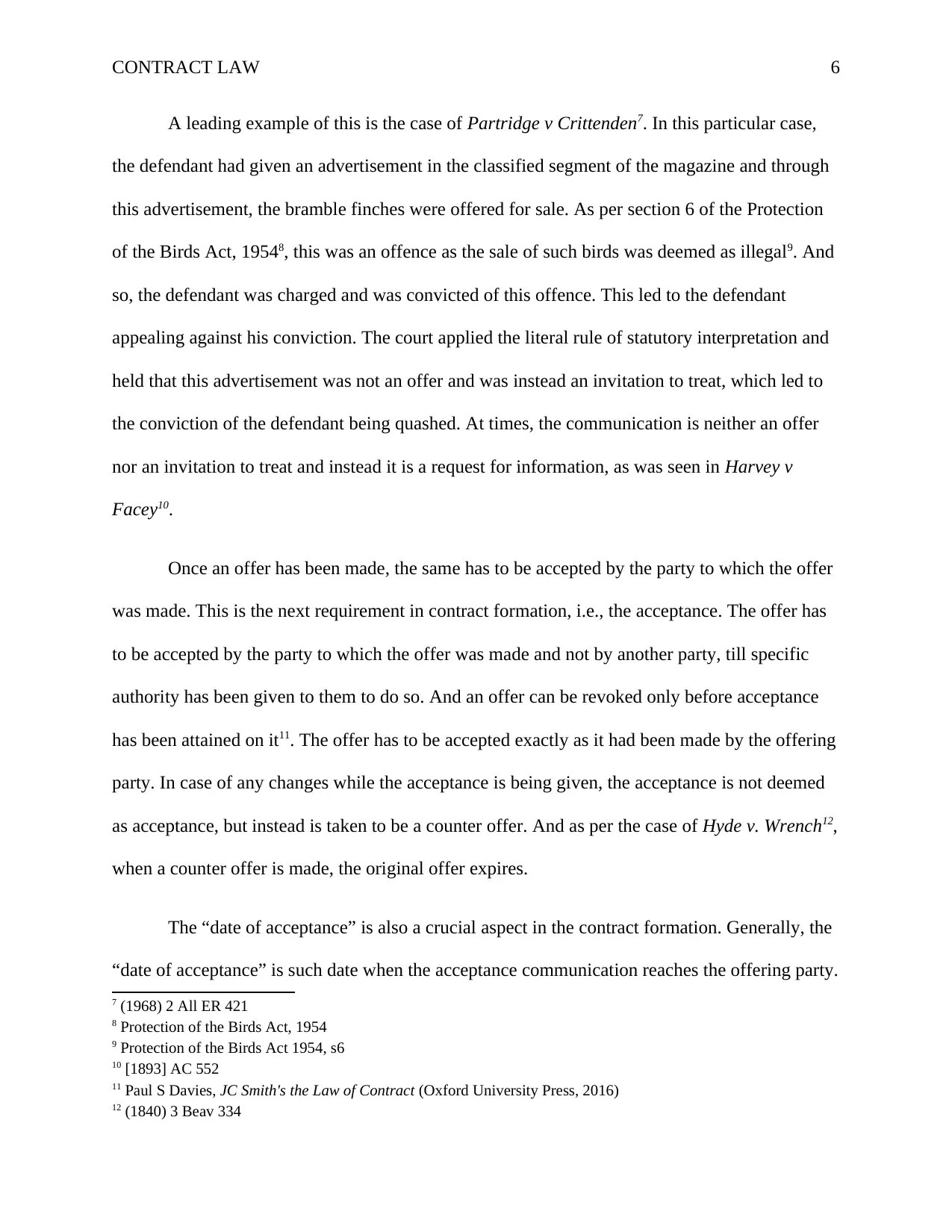
CONTRACT LAW 6
A leading example of this is the case of Partridge v Crittenden7. In this particular case,
the defendant had given an advertisement in the classified segment of the magazine and through
this advertisement, the bramble finches were offered for sale. As per section 6 of the Protection
of the Birds Act, 19548, this was an offence as the sale of such birds was deemed as illegal9. And
so, the defendant was charged and was convicted of this offence. This led to the defendant
appealing against his conviction. The court applied the literal rule of statutory interpretation and
held that this advertisement was not an offer and was instead an invitation to treat, which led to
the conviction of the defendant being quashed. At times, the communication is neither an offer
nor an invitation to treat and instead it is a request for information, as was seen in Harvey v
Facey10.
Once an offer has been made, the same has to be accepted by the party to which the offer
was made. This is the next requirement in contract formation, i.e., the acceptance. The offer has
to be accepted by the party to which the offer was made and not by another party, till specific
authority has been given to them to do so. And an offer can be revoked only before acceptance
has been attained on it11. The offer has to be accepted exactly as it had been made by the offering
party. In case of any changes while the acceptance is being given, the acceptance is not deemed
as acceptance, but instead is taken to be a counter offer. And as per the case of Hyde v. Wrench12,
when a counter offer is made, the original offer expires.
The “date of acceptance” is also a crucial aspect in the contract formation. Generally, the
“date of acceptance” is such date when the acceptance communication reaches the offering party.
7 (1968) 2 All ER 421
8 Protection of the Birds Act, 1954
9 Protection of the Birds Act 1954, s6
10 [1893] AC 552
11 Paul S Davies, JC Smith's the Law of Contract (Oxford University Press, 2016)
12 (1840) 3 Beav 334
A leading example of this is the case of Partridge v Crittenden7. In this particular case,
the defendant had given an advertisement in the classified segment of the magazine and through
this advertisement, the bramble finches were offered for sale. As per section 6 of the Protection
of the Birds Act, 19548, this was an offence as the sale of such birds was deemed as illegal9. And
so, the defendant was charged and was convicted of this offence. This led to the defendant
appealing against his conviction. The court applied the literal rule of statutory interpretation and
held that this advertisement was not an offer and was instead an invitation to treat, which led to
the conviction of the defendant being quashed. At times, the communication is neither an offer
nor an invitation to treat and instead it is a request for information, as was seen in Harvey v
Facey10.
Once an offer has been made, the same has to be accepted by the party to which the offer
was made. This is the next requirement in contract formation, i.e., the acceptance. The offer has
to be accepted by the party to which the offer was made and not by another party, till specific
authority has been given to them to do so. And an offer can be revoked only before acceptance
has been attained on it11. The offer has to be accepted exactly as it had been made by the offering
party. In case of any changes while the acceptance is being given, the acceptance is not deemed
as acceptance, but instead is taken to be a counter offer. And as per the case of Hyde v. Wrench12,
when a counter offer is made, the original offer expires.
The “date of acceptance” is also a crucial aspect in the contract formation. Generally, the
“date of acceptance” is such date when the acceptance communication reaches the offering party.
7 (1968) 2 All ER 421
8 Protection of the Birds Act, 1954
9 Protection of the Birds Act 1954, s6
10 [1893] AC 552
11 Paul S Davies, JC Smith's the Law of Contract (Oxford University Press, 2016)
12 (1840) 3 Beav 334
⊘ This is a preview!⊘
Do you want full access?
Subscribe today to unlock all pages.

Trusted by 1+ million students worldwide
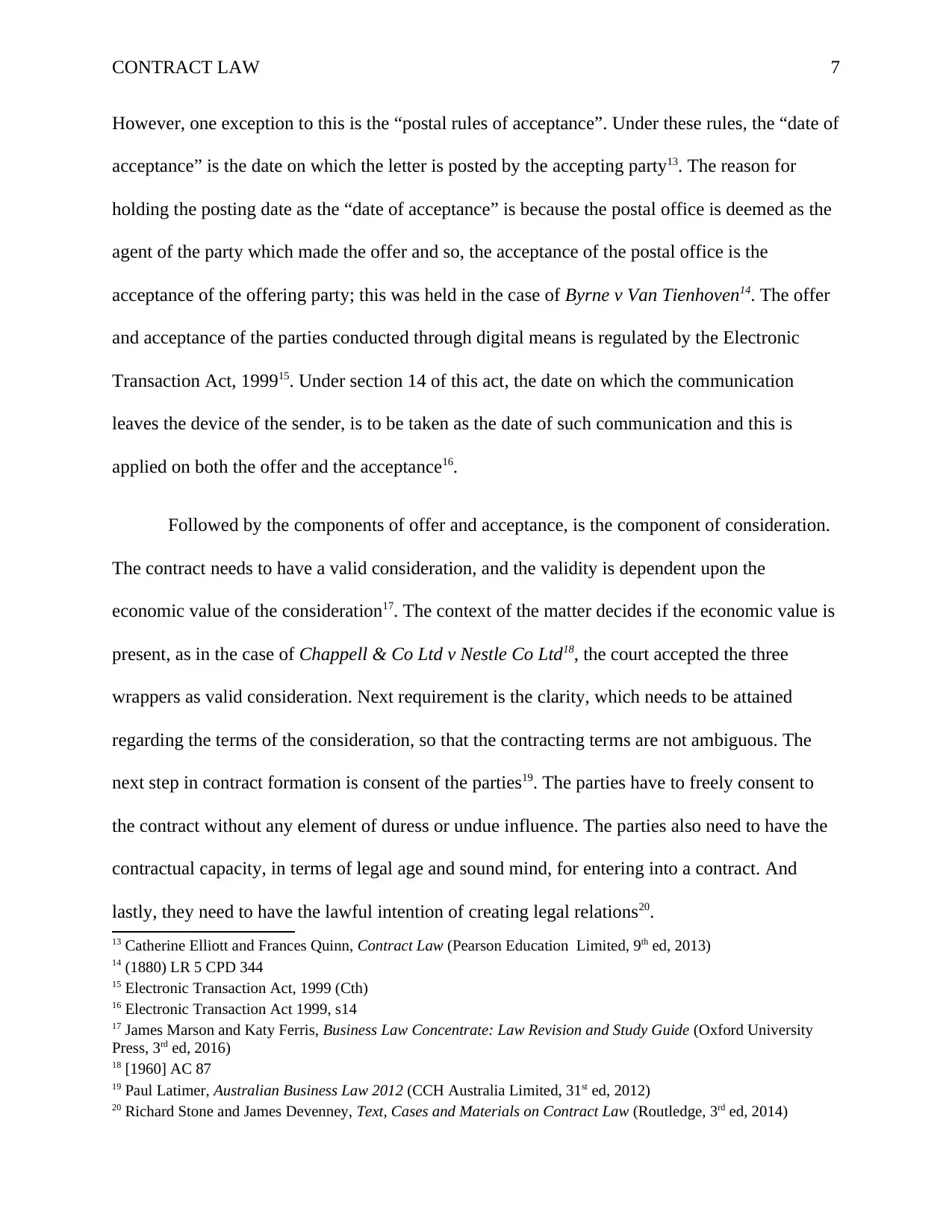
CONTRACT LAW 7
However, one exception to this is the “postal rules of acceptance”. Under these rules, the “date of
acceptance” is the date on which the letter is posted by the accepting party13. The reason for
holding the posting date as the “date of acceptance” is because the postal office is deemed as the
agent of the party which made the offer and so, the acceptance of the postal office is the
acceptance of the offering party; this was held in the case of Byrne v Van Tienhoven14. The offer
and acceptance of the parties conducted through digital means is regulated by the Electronic
Transaction Act, 199915. Under section 14 of this act, the date on which the communication
leaves the device of the sender, is to be taken as the date of such communication and this is
applied on both the offer and the acceptance16.
Followed by the components of offer and acceptance, is the component of consideration.
The contract needs to have a valid consideration, and the validity is dependent upon the
economic value of the consideration17. The context of the matter decides if the economic value is
present, as in the case of Chappell & Co Ltd v Nestle Co Ltd18, the court accepted the three
wrappers as valid consideration. Next requirement is the clarity, which needs to be attained
regarding the terms of the consideration, so that the contracting terms are not ambiguous. The
next step in contract formation is consent of the parties19. The parties have to freely consent to
the contract without any element of duress or undue influence. The parties also need to have the
contractual capacity, in terms of legal age and sound mind, for entering into a contract. And
lastly, they need to have the lawful intention of creating legal relations20.
13 Catherine Elliott and Frances Quinn, Contract Law (Pearson Education Limited, 9th ed, 2013)
14 (1880) LR 5 CPD 344
15 Electronic Transaction Act, 1999 (Cth)
16 Electronic Transaction Act 1999, s14
17 James Marson and Katy Ferris, Business Law Concentrate: Law Revision and Study Guide (Oxford University
Press, 3rd ed, 2016)
18 [1960] AC 87
19 Paul Latimer, Australian Business Law 2012 (CCH Australia Limited, 31st ed, 2012)
20 Richard Stone and James Devenney, Text, Cases and Materials on Contract Law (Routledge, 3rd ed, 2014)
However, one exception to this is the “postal rules of acceptance”. Under these rules, the “date of
acceptance” is the date on which the letter is posted by the accepting party13. The reason for
holding the posting date as the “date of acceptance” is because the postal office is deemed as the
agent of the party which made the offer and so, the acceptance of the postal office is the
acceptance of the offering party; this was held in the case of Byrne v Van Tienhoven14. The offer
and acceptance of the parties conducted through digital means is regulated by the Electronic
Transaction Act, 199915. Under section 14 of this act, the date on which the communication
leaves the device of the sender, is to be taken as the date of such communication and this is
applied on both the offer and the acceptance16.
Followed by the components of offer and acceptance, is the component of consideration.
The contract needs to have a valid consideration, and the validity is dependent upon the
economic value of the consideration17. The context of the matter decides if the economic value is
present, as in the case of Chappell & Co Ltd v Nestle Co Ltd18, the court accepted the three
wrappers as valid consideration. Next requirement is the clarity, which needs to be attained
regarding the terms of the consideration, so that the contracting terms are not ambiguous. The
next step in contract formation is consent of the parties19. The parties have to freely consent to
the contract without any element of duress or undue influence. The parties also need to have the
contractual capacity, in terms of legal age and sound mind, for entering into a contract. And
lastly, they need to have the lawful intention of creating legal relations20.
13 Catherine Elliott and Frances Quinn, Contract Law (Pearson Education Limited, 9th ed, 2013)
14 (1880) LR 5 CPD 344
15 Electronic Transaction Act, 1999 (Cth)
16 Electronic Transaction Act 1999, s14
17 James Marson and Katy Ferris, Business Law Concentrate: Law Revision and Study Guide (Oxford University
Press, 3rd ed, 2016)
18 [1960] AC 87
19 Paul Latimer, Australian Business Law 2012 (CCH Australia Limited, 31st ed, 2012)
20 Richard Stone and James Devenney, Text, Cases and Materials on Contract Law (Routledge, 3rd ed, 2014)
Paraphrase This Document
Need a fresh take? Get an instant paraphrase of this document with our AI Paraphraser
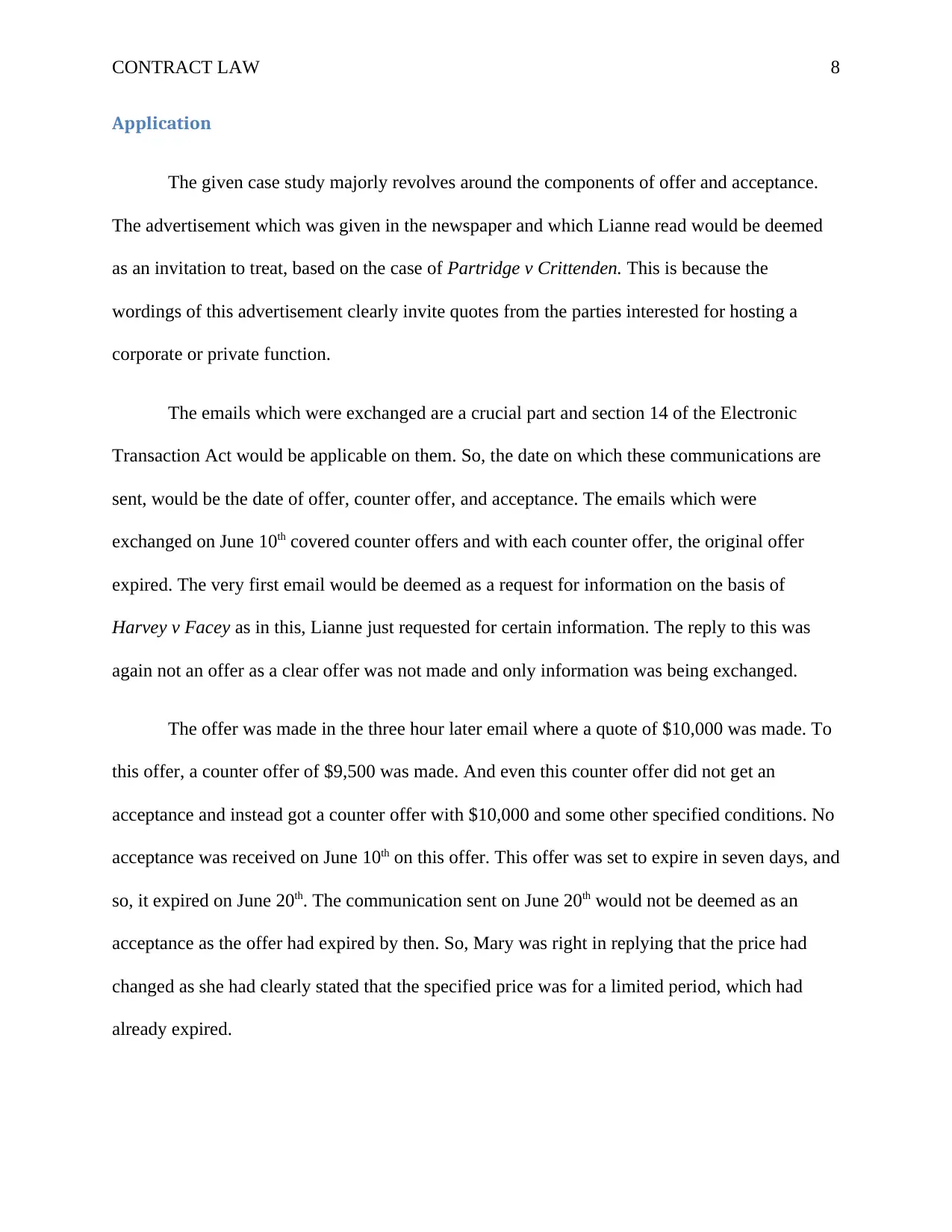
CONTRACT LAW 8
Application
The given case study majorly revolves around the components of offer and acceptance.
The advertisement which was given in the newspaper and which Lianne read would be deemed
as an invitation to treat, based on the case of Partridge v Crittenden. This is because the
wordings of this advertisement clearly invite quotes from the parties interested for hosting a
corporate or private function.
The emails which were exchanged are a crucial part and section 14 of the Electronic
Transaction Act would be applicable on them. So, the date on which these communications are
sent, would be the date of offer, counter offer, and acceptance. The emails which were
exchanged on June 10th covered counter offers and with each counter offer, the original offer
expired. The very first email would be deemed as a request for information on the basis of
Harvey v Facey as in this, Lianne just requested for certain information. The reply to this was
again not an offer as a clear offer was not made and only information was being exchanged.
The offer was made in the three hour later email where a quote of $10,000 was made. To
this offer, a counter offer of $9,500 was made. And even this counter offer did not get an
acceptance and instead got a counter offer with $10,000 and some other specified conditions. No
acceptance was received on June 10th on this offer. This offer was set to expire in seven days, and
so, it expired on June 20th. The communication sent on June 20th would not be deemed as an
acceptance as the offer had expired by then. So, Mary was right in replying that the price had
changed as she had clearly stated that the specified price was for a limited period, which had
already expired.
Application
The given case study majorly revolves around the components of offer and acceptance.
The advertisement which was given in the newspaper and which Lianne read would be deemed
as an invitation to treat, based on the case of Partridge v Crittenden. This is because the
wordings of this advertisement clearly invite quotes from the parties interested for hosting a
corporate or private function.
The emails which were exchanged are a crucial part and section 14 of the Electronic
Transaction Act would be applicable on them. So, the date on which these communications are
sent, would be the date of offer, counter offer, and acceptance. The emails which were
exchanged on June 10th covered counter offers and with each counter offer, the original offer
expired. The very first email would be deemed as a request for information on the basis of
Harvey v Facey as in this, Lianne just requested for certain information. The reply to this was
again not an offer as a clear offer was not made and only information was being exchanged.
The offer was made in the three hour later email where a quote of $10,000 was made. To
this offer, a counter offer of $9,500 was made. And even this counter offer did not get an
acceptance and instead got a counter offer with $10,000 and some other specified conditions. No
acceptance was received on June 10th on this offer. This offer was set to expire in seven days, and
so, it expired on June 20th. The communication sent on June 20th would not be deemed as an
acceptance as the offer had expired by then. So, Mary was right in replying that the price had
changed as she had clearly stated that the specified price was for a limited period, which had
already expired.
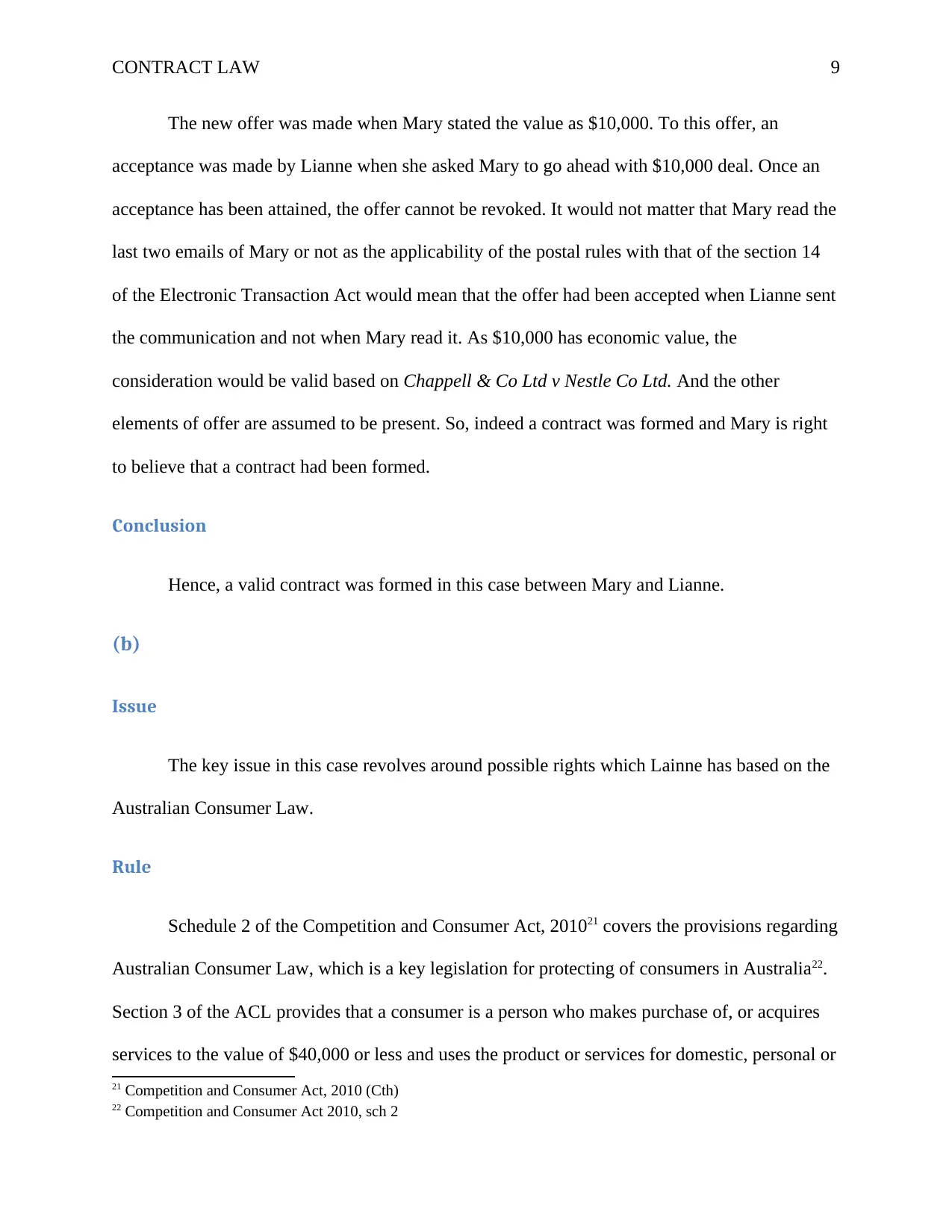
CONTRACT LAW 9
The new offer was made when Mary stated the value as $10,000. To this offer, an
acceptance was made by Lianne when she asked Mary to go ahead with $10,000 deal. Once an
acceptance has been attained, the offer cannot be revoked. It would not matter that Mary read the
last two emails of Mary or not as the applicability of the postal rules with that of the section 14
of the Electronic Transaction Act would mean that the offer had been accepted when Lianne sent
the communication and not when Mary read it. As $10,000 has economic value, the
consideration would be valid based on Chappell & Co Ltd v Nestle Co Ltd. And the other
elements of offer are assumed to be present. So, indeed a contract was formed and Mary is right
to believe that a contract had been formed.
Conclusion
Hence, a valid contract was formed in this case between Mary and Lianne.
(b)
Issue
The key issue in this case revolves around possible rights which Lainne has based on the
Australian Consumer Law.
Rule
Schedule 2 of the Competition and Consumer Act, 201021 covers the provisions regarding
Australian Consumer Law, which is a key legislation for protecting of consumers in Australia22.
Section 3 of the ACL provides that a consumer is a person who makes purchase of, or acquires
services to the value of $40,000 or less and uses the product or services for domestic, personal or
21 Competition and Consumer Act, 2010 (Cth)
22 Competition and Consumer Act 2010, sch 2
The new offer was made when Mary stated the value as $10,000. To this offer, an
acceptance was made by Lianne when she asked Mary to go ahead with $10,000 deal. Once an
acceptance has been attained, the offer cannot be revoked. It would not matter that Mary read the
last two emails of Mary or not as the applicability of the postal rules with that of the section 14
of the Electronic Transaction Act would mean that the offer had been accepted when Lianne sent
the communication and not when Mary read it. As $10,000 has economic value, the
consideration would be valid based on Chappell & Co Ltd v Nestle Co Ltd. And the other
elements of offer are assumed to be present. So, indeed a contract was formed and Mary is right
to believe that a contract had been formed.
Conclusion
Hence, a valid contract was formed in this case between Mary and Lianne.
(b)
Issue
The key issue in this case revolves around possible rights which Lainne has based on the
Australian Consumer Law.
Rule
Schedule 2 of the Competition and Consumer Act, 201021 covers the provisions regarding
Australian Consumer Law, which is a key legislation for protecting of consumers in Australia22.
Section 3 of the ACL provides that a consumer is a person who makes purchase of, or acquires
services to the value of $40,000 or less and uses the product or services for domestic, personal or
21 Competition and Consumer Act, 2010 (Cth)
22 Competition and Consumer Act 2010, sch 2
⊘ This is a preview!⊘
Do you want full access?
Subscribe today to unlock all pages.

Trusted by 1+ million students worldwide
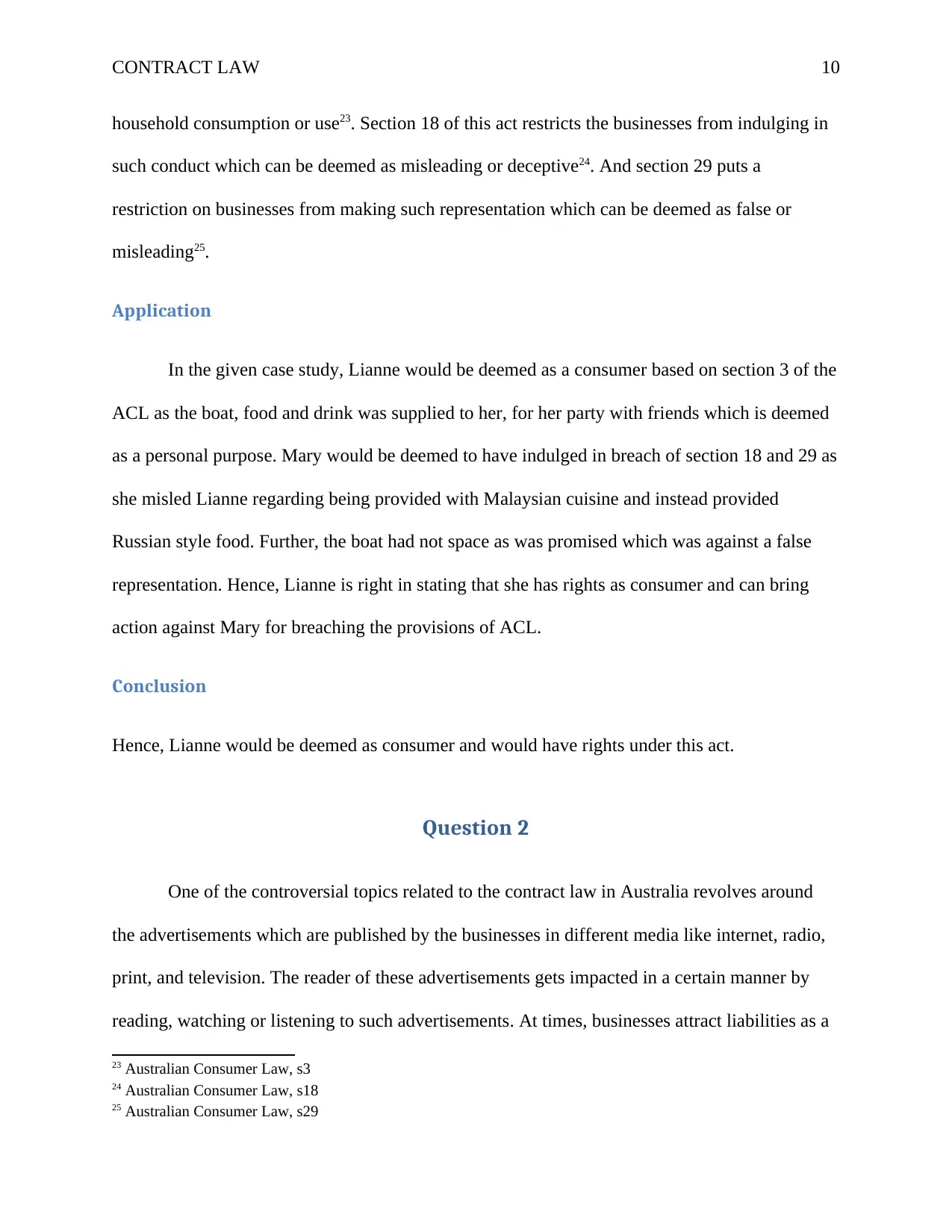
CONTRACT LAW 10
household consumption or use23. Section 18 of this act restricts the businesses from indulging in
such conduct which can be deemed as misleading or deceptive24. And section 29 puts a
restriction on businesses from making such representation which can be deemed as false or
misleading25.
Application
In the given case study, Lianne would be deemed as a consumer based on section 3 of the
ACL as the boat, food and drink was supplied to her, for her party with friends which is deemed
as a personal purpose. Mary would be deemed to have indulged in breach of section 18 and 29 as
she misled Lianne regarding being provided with Malaysian cuisine and instead provided
Russian style food. Further, the boat had not space as was promised which was against a false
representation. Hence, Lianne is right in stating that she has rights as consumer and can bring
action against Mary for breaching the provisions of ACL.
Conclusion
Hence, Lianne would be deemed as consumer and would have rights under this act.
Question 2
One of the controversial topics related to the contract law in Australia revolves around
the advertisements which are published by the businesses in different media like internet, radio,
print, and television. The reader of these advertisements gets impacted in a certain manner by
reading, watching or listening to such advertisements. At times, businesses attract liabilities as a
23 Australian Consumer Law, s3
24 Australian Consumer Law, s18
25 Australian Consumer Law, s29
household consumption or use23. Section 18 of this act restricts the businesses from indulging in
such conduct which can be deemed as misleading or deceptive24. And section 29 puts a
restriction on businesses from making such representation which can be deemed as false or
misleading25.
Application
In the given case study, Lianne would be deemed as a consumer based on section 3 of the
ACL as the boat, food and drink was supplied to her, for her party with friends which is deemed
as a personal purpose. Mary would be deemed to have indulged in breach of section 18 and 29 as
she misled Lianne regarding being provided with Malaysian cuisine and instead provided
Russian style food. Further, the boat had not space as was promised which was against a false
representation. Hence, Lianne is right in stating that she has rights as consumer and can bring
action against Mary for breaching the provisions of ACL.
Conclusion
Hence, Lianne would be deemed as consumer and would have rights under this act.
Question 2
One of the controversial topics related to the contract law in Australia revolves around
the advertisements which are published by the businesses in different media like internet, radio,
print, and television. The reader of these advertisements gets impacted in a certain manner by
reading, watching or listening to such advertisements. At times, businesses attract liabilities as a
23 Australian Consumer Law, s3
24 Australian Consumer Law, s18
25 Australian Consumer Law, s29
Paraphrase This Document
Need a fresh take? Get an instant paraphrase of this document with our AI Paraphraser
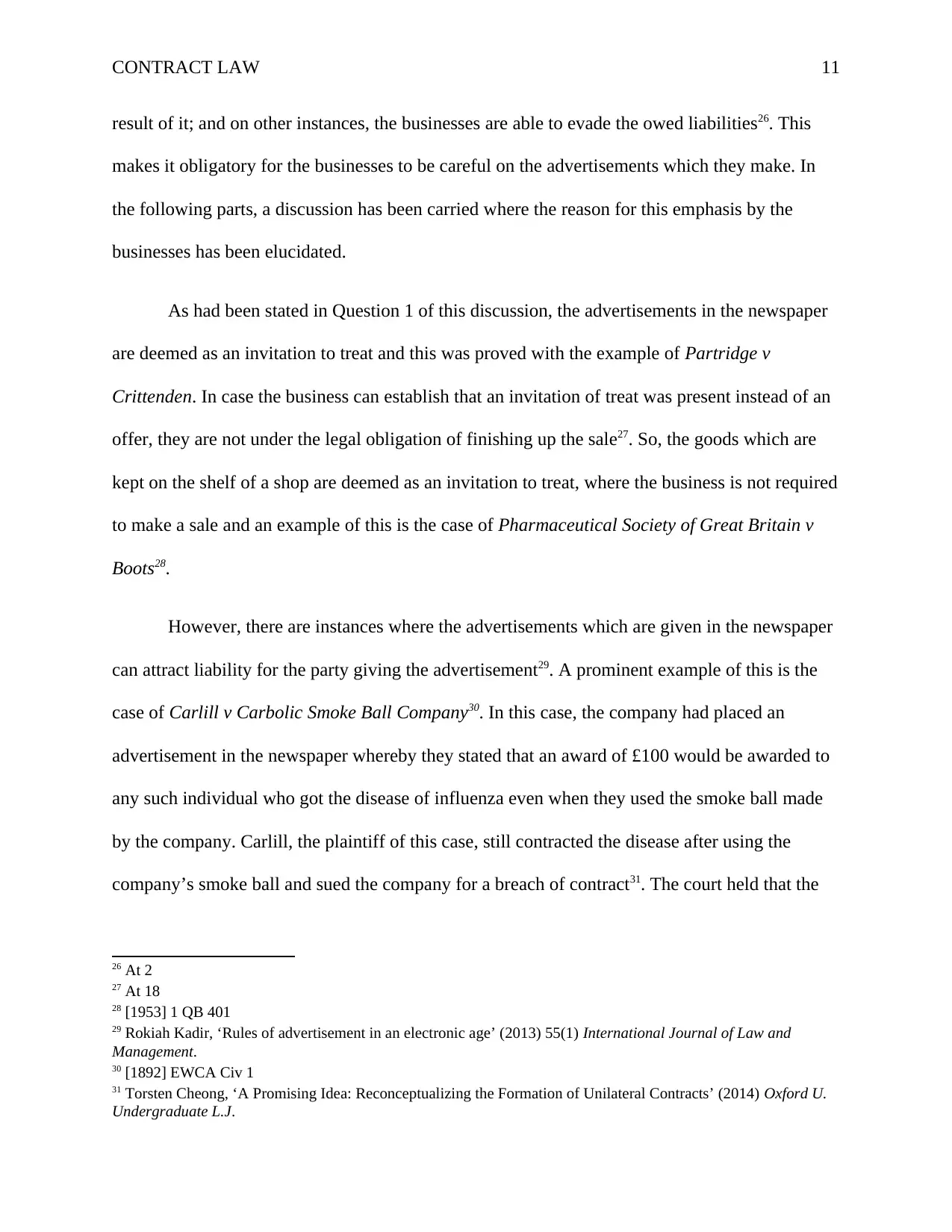
CONTRACT LAW 11
result of it; and on other instances, the businesses are able to evade the owed liabilities26. This
makes it obligatory for the businesses to be careful on the advertisements which they make. In
the following parts, a discussion has been carried where the reason for this emphasis by the
businesses has been elucidated.
As had been stated in Question 1 of this discussion, the advertisements in the newspaper
are deemed as an invitation to treat and this was proved with the example of Partridge v
Crittenden. In case the business can establish that an invitation of treat was present instead of an
offer, they are not under the legal obligation of finishing up the sale27. So, the goods which are
kept on the shelf of a shop are deemed as an invitation to treat, where the business is not required
to make a sale and an example of this is the case of Pharmaceutical Society of Great Britain v
Boots28.
However, there are instances where the advertisements which are given in the newspaper
can attract liability for the party giving the advertisement29. A prominent example of this is the
case of Carlill v Carbolic Smoke Ball Company30. In this case, the company had placed an
advertisement in the newspaper whereby they stated that an award of £100 would be awarded to
any such individual who got the disease of influenza even when they used the smoke ball made
by the company. Carlill, the plaintiff of this case, still contracted the disease after using the
company’s smoke ball and sued the company for a breach of contract31. The court held that the
26 At 2
27 At 18
28 [1953] 1 QB 401
29 Rokiah Kadir, ‘Rules of advertisement in an electronic age’ (2013) 55(1) International Journal of Law and
Management.
30 [1892] EWCA Civ 1
31 Torsten Cheong, ‘A Promising Idea: Reconceptualizing the Formation of Unilateral Contracts’ (2014) Oxford U.
Undergraduate L.J.
result of it; and on other instances, the businesses are able to evade the owed liabilities26. This
makes it obligatory for the businesses to be careful on the advertisements which they make. In
the following parts, a discussion has been carried where the reason for this emphasis by the
businesses has been elucidated.
As had been stated in Question 1 of this discussion, the advertisements in the newspaper
are deemed as an invitation to treat and this was proved with the example of Partridge v
Crittenden. In case the business can establish that an invitation of treat was present instead of an
offer, they are not under the legal obligation of finishing up the sale27. So, the goods which are
kept on the shelf of a shop are deemed as an invitation to treat, where the business is not required
to make a sale and an example of this is the case of Pharmaceutical Society of Great Britain v
Boots28.
However, there are instances where the advertisements which are given in the newspaper
can attract liability for the party giving the advertisement29. A prominent example of this is the
case of Carlill v Carbolic Smoke Ball Company30. In this case, the company had placed an
advertisement in the newspaper whereby they stated that an award of £100 would be awarded to
any such individual who got the disease of influenza even when they used the smoke ball made
by the company. Carlill, the plaintiff of this case, still contracted the disease after using the
company’s smoke ball and sued the company for a breach of contract31. The court held that the
26 At 2
27 At 18
28 [1953] 1 QB 401
29 Rokiah Kadir, ‘Rules of advertisement in an electronic age’ (2013) 55(1) International Journal of Law and
Management.
30 [1892] EWCA Civ 1
31 Torsten Cheong, ‘A Promising Idea: Reconceptualizing the Formation of Unilateral Contracts’ (2014) Oxford U.
Undergraduate L.J.
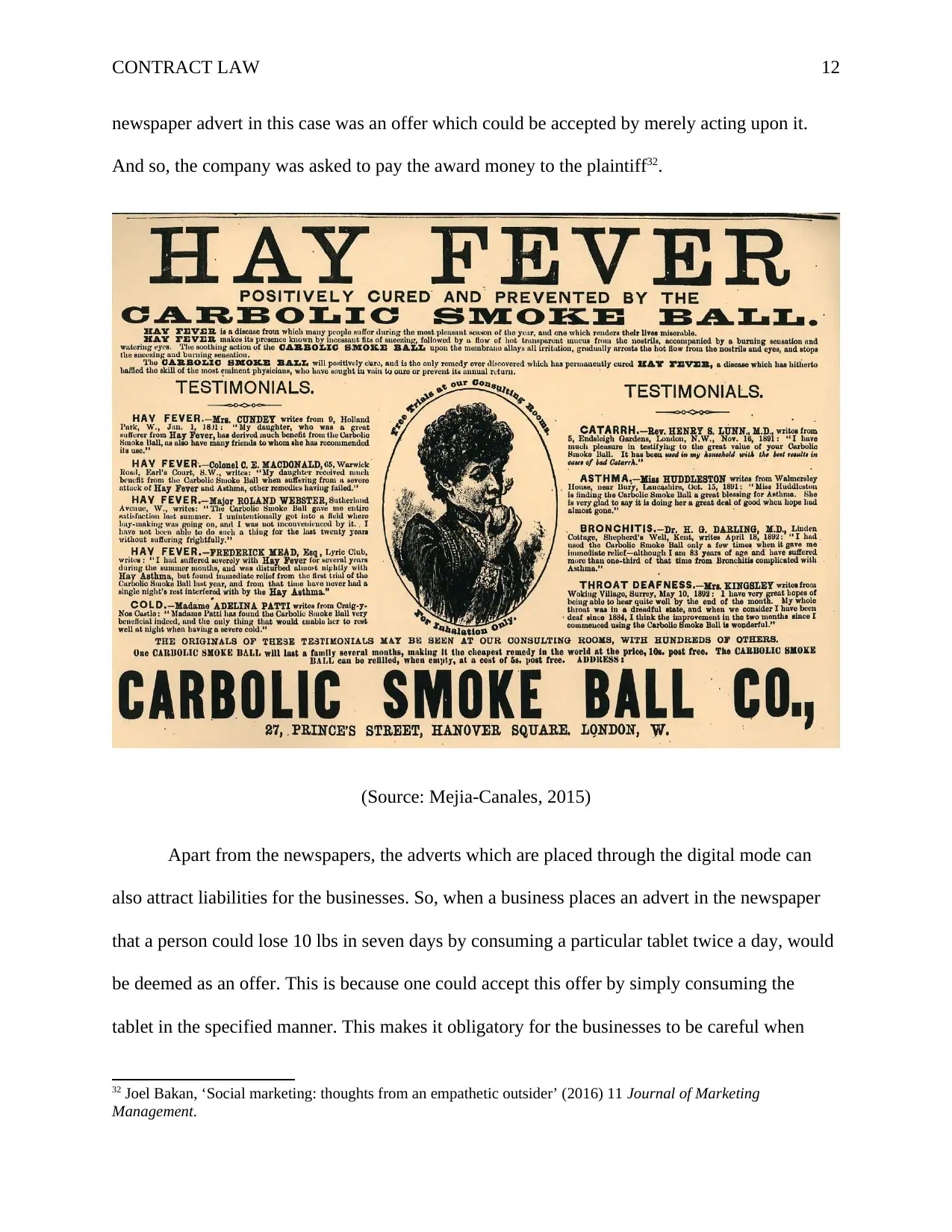
CONTRACT LAW 12
newspaper advert in this case was an offer which could be accepted by merely acting upon it.
And so, the company was asked to pay the award money to the plaintiff32.
(Source: Mejia-Canales, 2015)
Apart from the newspapers, the adverts which are placed through the digital mode can
also attract liabilities for the businesses. So, when a business places an advert in the newspaper
that a person could lose 10 lbs in seven days by consuming a particular tablet twice a day, would
be deemed as an offer. This is because one could accept this offer by simply consuming the
tablet in the specified manner. This makes it obligatory for the businesses to be careful when
32 Joel Bakan, ‘Social marketing: thoughts from an empathetic outsider’ (2016) 11 Journal of Marketing
Management.
newspaper advert in this case was an offer which could be accepted by merely acting upon it.
And so, the company was asked to pay the award money to the plaintiff32.
(Source: Mejia-Canales, 2015)
Apart from the newspapers, the adverts which are placed through the digital mode can
also attract liabilities for the businesses. So, when a business places an advert in the newspaper
that a person could lose 10 lbs in seven days by consuming a particular tablet twice a day, would
be deemed as an offer. This is because one could accept this offer by simply consuming the
tablet in the specified manner. This makes it obligatory for the businesses to be careful when
32 Joel Bakan, ‘Social marketing: thoughts from an empathetic outsider’ (2016) 11 Journal of Marketing
Management.
⊘ This is a preview!⊘
Do you want full access?
Subscribe today to unlock all pages.

Trusted by 1+ million students worldwide
1 out of 16
Related Documents
Your All-in-One AI-Powered Toolkit for Academic Success.
+13062052269
info@desklib.com
Available 24*7 on WhatsApp / Email
![[object Object]](/_next/static/media/star-bottom.7253800d.svg)
Unlock your academic potential
Copyright © 2020–2025 A2Z Services. All Rights Reserved. Developed and managed by ZUCOL.





